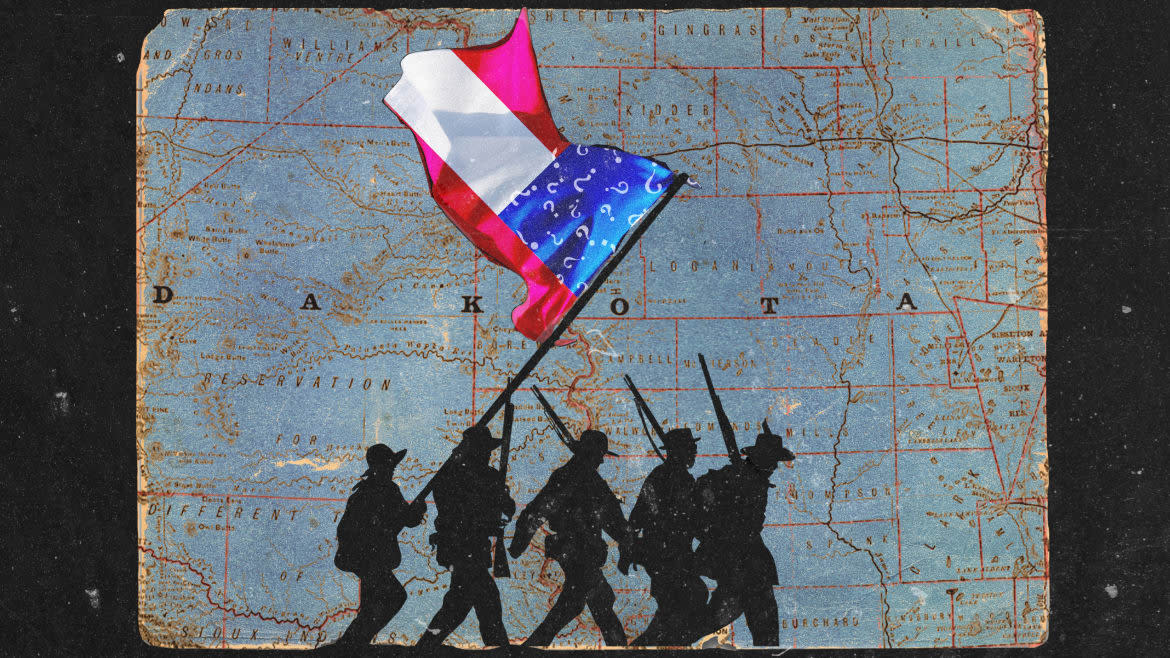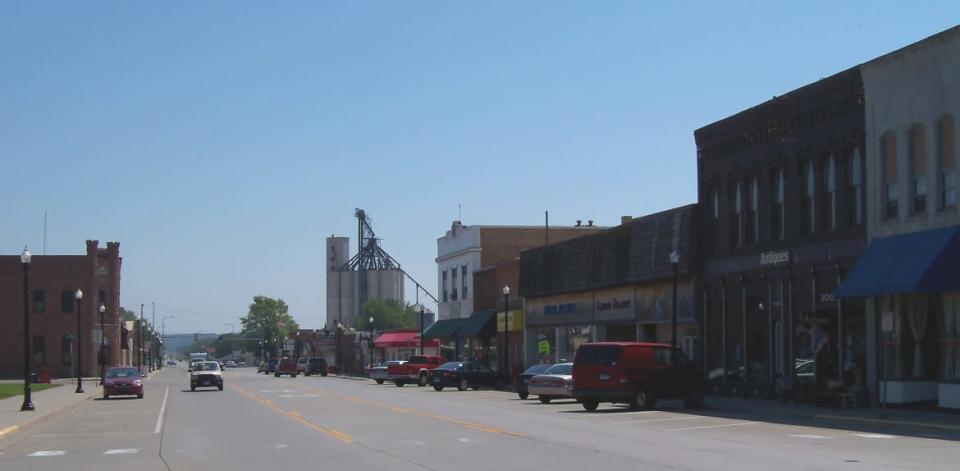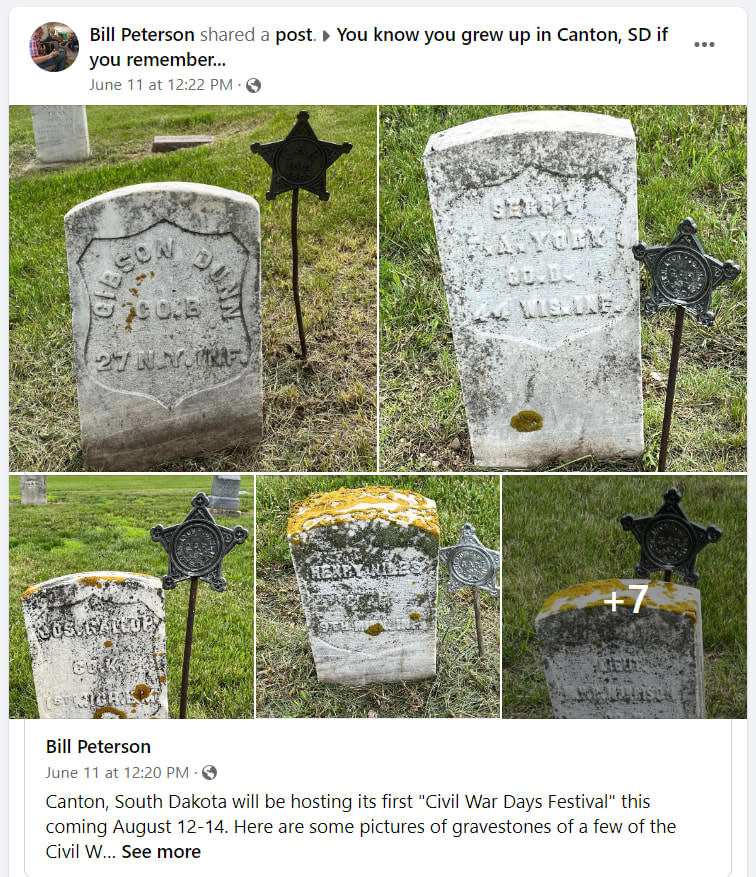South Dakota Town’s Civil War Festival Is a Big WTF

- Oops!Something went wrong.Please try again later.
CANTON, South Dakota—South Dakota wasn’t a state during the Civil War. Founded in 1889, it didn’t send troops into battle.
But an event this summer in Canton, a small town southeast of Sioux Falls, will feature a pair of skirmishes between the Blue and the Gray. A logo for Canton Civil War Days, set for Aug. 12-14, shows both the American flag and a Confederate banner.
Selwyn Jones of Gettysburg—who is the uncle of George Floyd, the Black man killed by a Minneapolis police officer in 2020—said he could fathom a Civil War event in his home state of North Carolina. But in South Dakota, with the Canton Chamber of Commerce sponsoring it?
“The Confederate flag should literally be like the swastika is,” Jones told The Daily Beast. “If you display a swastika in Germany, you are automatically arrested. If you mention Hitler’s name, your ass is obviously arrested.”
Jones isn’t alone in his opposition to the weekend gathering in Canton, a town of 3,500 in a state with a Black population of just over 2 percent. Other South Dakotans raised objections online and in interviews with the use of the the Confederate flag at the event, which is being billed as a history celebration by the organizer.
“South Dakota wasn’t even South Dakota during the Civil War—absolutely no good reason to observe Civil War days up here,” said Elizabeth Parham, 61, of Huron, who is retired from the U.S. Air Force.
“The only circumstance I can think it’s okay to use the flag is in a historical re-enactment. I’m not sure that’s what is happening in Canton.”
In the 1860s, Dakota Territory was largely under the control of the Lakota, Dakota and Nakota people. No Civil War battles were fought in the region.
In the decades following the war, tens of thousands of veterans headed west in search of land and opportunity. Many of South Dakota’s earliest settlers were veterans of the Grand Army of the Republic, the men in blue who won the war.
They left reminders of their service on the map, naming towns for battles, such as Gettysburg, and counties like Lincoln and Grant. Many Northern veterans became early leaders, such as Arthur Mellette, the last governor of Dakota Territory and first governor of South Dakota.
Although few Southern soldiers settled in the state, Confederate flags have popped up around South Dakota in recent years, hanging from the backs of pickups or porches.
During a June celebration in Harrisburg, a small town near Canton, a teenage boy walked around wearing the stars and bars like a cape, angering one woman who posted a video on Twitter.
“As seen at Harrisburg Days in Harrisburg SD. Racists come pick up your kids,” she wrote.
Dave Renli, a Sioux Falls resident and Civil War re-enactor, is the driving force behind this new festival. He said he was inspired to learn more about the Civil War while touring the Gettysburg, Pennsylvania, battlefield during his work as a firefighter instructor on the East Coast in the 1990s.
“It’s an amazing site,” he told The Daily Beast. “It stirs the heart when you get there and look around and you read the stories.”
He has since visited several Civil War battlefields, and was an extra in the 1993 film “Gettysburg,” where he had lunch next to actor Jeff Daniels, who played Col. Joshua Chamberlain.

Downtown Canton, South Dakota.
Renli said he gave thought to how people react to seeing men in Southern uniforms waving the rebel flag and said he would “not be happy” to see one on a vehicle or home.
But in a historical setting, he thinks it has its place, with people learning about both states’ rights and slavery that fueled the war.
“I think if you met most of the re-enactors, you would know there’s a portion of history that is dark,” Renli said. “In order to portray history as it was, not as we wish it were, sometimes you have to bring up things that were dark.”
“The flag as it originated, I don’t think it specifically exemplified slavery,” he said. “I think it has certainly come to mean things that are horrible, white supremacist stuff and all that. But I think on a battlefield, at a re-enactment, it’s not inappropriate to show it, as long as it is not being glorified.”
He said people are more sensitive about the Southern flag “in some sections, in some areas” now, but there are also some people who feel the U.S. flag represents patriarchy and slave-ownership.
“I’ve heard people, and posts that they don’t think that flag is a good flag, either, that it represents evil. So, where do you draw the line?”
Renli is a part of a Sioux Falls re-enactors group and owns both blue and gray uniforms, having portrayed both Northern and Southern soldiers.
Canton resident Bill Peterson will perform period music during the weekend. He noted that while Canton didn’t exist during the war, 70 Civil War veterans are buried in the city cemetery.
“I probably agree that you don’t want to be waving the flag around or anything but if it’s a re-enactment, it’s history,” Peterson said. “Part of it is, you can’t erase history.”
He says he has seen negative comments on social media.
“Sometimes you wonder if they just do it to raise a ruckus or if they want to argue,” Peterson said.

The Canton event was created after nearby Pipestone, Minnesota, canceled its Civil War event in 2020 and 2021 due to COVID and because its organizers were aging. Unlike South Dakota, Minnesota was a part of the Union during the Civil War and sent troops to battle.
Renli helped shift the event to Canton. About 40 Northern and 40 Southern “soldiers” are expected to meet in combat on Saturday and Sunday afternoon, Aug. 13-14.
“The battle scenarios are based on small-scale encounters during the Union victory at Hatcher Run VA,” Renli posted. “There are special speakers. A Lady who will speak about fashion, a gentleman who portrays Frederick Douglass, a family who talks about children games and toys of the 1860s to name a few.”
He told The Daily Beast the South will likely win on Saturday and the North will triumph on Sunday.
In addition to the faux battles, a dance will be held Saturday, Aug. 13. Peterson put a band together that will perform period music for the event—which one critic said was an “homage to antebellum South lifestyle.”
The Killing That Set Off a ‘Race War’ in South Dakota
The use of the Confederate flag also stirred controversy in South Dakota in 2020 when it was noticed that the small town of Gettysburg, named for the Civil War battle, had both the American and Confederate flags on its police vehicles and uniforms.
The city of Gettysburg initially defended the use of the Confederate flag on its police cars and uniforms, saying it had “no racist intentions” and was meant to represent the city heritage and the nation’s unification. “Without the war, and without the Battle of Gettysburg, we would not be the same City that we are,” the city said.
After considerable media attention, however, the city changed course and had the logo removed from squad cars and police uniforms in July 2020.
Jones—who came to South Dakota to play indoor football in Rapid City and settled down in his wife’s hometown of Gettysburg—was among those who objected to the inclusion of the Confederate banner on city property.
As a result, he said, he became an outcast and feels unwelcome at most local businesses. “I feel like I’m living in a box most of the time,” Jones said. “But I’m going to stay as long as my heart tells me.”
Get the Daily Beast's biggest scoops and scandals delivered right to your inbox. Sign up now.
Stay informed and gain unlimited access to the Daily Beast's unmatched reporting. Subscribe now.

